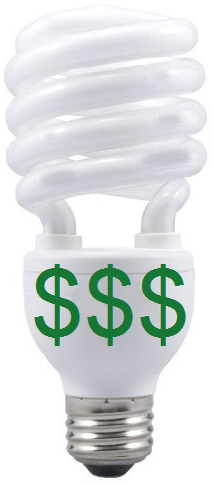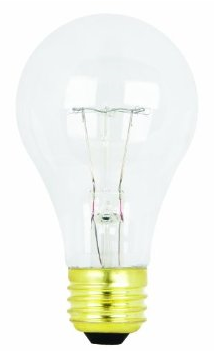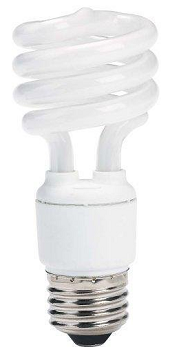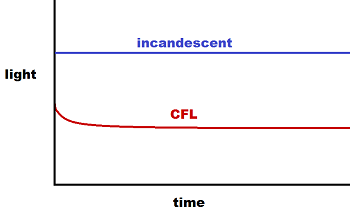I have a frugal friend named David. When we get together, we frequently bicker about frugality. Then David went to Mexico for four months and needed somebody to watch his house. I just happened to be moving at the same time and it worked out for me to stay there. The first thing I did was replace the CFLs with incandescent lights. Over the four months I practiced all of the things that I think are frugal. For the seven years that David lived in that house, he never got his monthly power expense lower than $50. I got it down to $15.
David and I both work from home, so this little test will have a lot of apples to apples comparisons.
my lighting habits
Since this article is really about CFL, I want to point out that with my lighting habits, it probably doesn't really matter what sort of light bulb I use. During the day, I rely on daylight. At night, I turn on a single 40 watt incandescent light pointed at the ceiling. As I use the kitchen or bathroom, I'll use those lights for a few minutes. Just before bed, I use a 40 watt light in the bedroom for a minute or so. I use a few LED night lights.
Supposing I use the main light for three hours per night, that would be 1.2kwh in a month. 15 cents for a month. If CFL lived up to its claims, I might save a dime a month. It just isn't worth screwing with.
All of my lighting stuff might add up to 40 or 50 cents a month. I think David uses more lights. Maybe $1.50 or $2 per month.
So when I see massive campaigns to save energy by switching to CFLs, I cannot help but think that even if CFLs worked as claimed, it would require that people use lights hundreds of times more than I do. And I have a really hard time imagining people doing that. People must be turning on all of their lights and leaving them on all day and all night. In which case, they will save far more money by turning their lights off when they are asleep, or not home, or pulling back the curtains during the day. No trip to the store required.
the clothes dryer
To dry my clothes in David's really old dryer typically took an hour and a half. The average dryer uses 4,400 watts. So this works out to 6.6kwh. The cost of electricity at David's house is 12.5 cents per kwh. So each load of laundry is $0.825. At two loads per week, that works out to $7.095 per month. I have these spiffy clothes drying racks I use.
heating
David's place uses electric heat. I know that David will wait until he feels cold until he turns the heat on. David is developing a healthy relationship with the thermostat: turning it up when he feels cold, turning it down at night, keeping it low when he is away, etc. I set the thermostat to 50 and when it started to get cold I would warm my immediate area. Mostly, I sat on a heating pad set on its lowest setting - the kind that you are supposed to use for a sore back. Using about 15 to 20 watts I think. Sometimes I used a personal heater set at the lowest setting. And about once a week in October I actually turned the central heat on for an hour.
I stayed at David's for July, August, September and October. And a pinch of November. There were a few days in the summer that got pretty cold - and I think David would have turned on the heat for the day. And then in September it got a lot colder. I think David would have run the heat nearly every day in October. Overall, I would guess that in July and August I cut $10 off the electric bill by using less heat. And then $25 in September and $50 in October.
Since then, I spent a winter in Montana, experimenting with all sorts of frugal personal warming stuff. I wrote about making the best of electric heat.
On the topic of heating, I have a house design that requires no heat. And for heating with wood in a conventional home, folks should be aware of the rocket mass heater which can heat your home with five times less wood.
computers and phantom load
David and I both work on computers all day. David does stuff to mitigate phantom load. I don't. We both use big tube-style monitors. Maybe I could have carved another 20 cents off of the $15 per month if I fiddled with the phantom load stuff - but I think it is too small to bother with.
hot water
I take shorter showers and I use a lot less water to wash dishes. I also wash my clothes with cold water. I would guess that I saved $15 per month by using less hot water.
the fridge
I filled the fridge with stuff. Including bottles of water I had no intention of drinking. I imagined that every time I opened the door, all of the cold air would spill onto the floor. With the fridge full, there is less air to re-cool. I would guess that that trick saved about $4 per month.
cooking
I think David and I are equally matched in how often we eat out vs. eating at home. Although David does a lot more with coffee and tea than I do. I make my coffee with this spiffy electric kettle that uses about a third the power of stove top kettle. My math says that David's coffee and tea costs about $5 per month in electricity. I'm rolling in at about 25 cents.
other ways to save electricity: summary
As I mentioned earlier, David and I bicker about this stuff. And for each point, every person has a different theory. And there are a lot of articles out there written by people that think they are saving power, but their power bill is still $200 per month. The key is what does the power bill say in the end.
For more information and to discuss more about my time at David's please visit this forum thread: bragging about my lower energy footprint.
My time at David's also inspired this forum thread: 20 ways to REALLY reduce your summer utility bills
an interesting thing for those with incandescent lights and electric heat
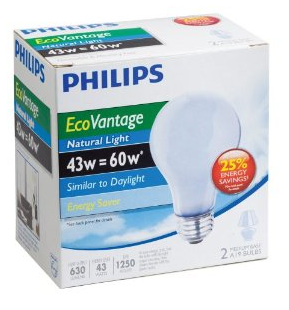
Supposing it is a really cold day and you will use a LOT of electric heat, then consider this: Every electric thing you run gives off heat. According to the laws of physics, it gives off the exact same amount of heat as your electric heater would put out. So if you were gonna use 10kwh of heat for the day, but you used 7kwh for lights, cooking and stuff like that, then you will end up using only 3kwh to run the heater to the same temperature. In other words, on a day that you are gonna run your electric heat, you get FREE electricity for everything else! Sort of. :)
Since it gets dark so early in winter, turn on lots and lots of incandescent lights! Make it plenty bright inside! It's free light! Do plenty of baking and cooking on that electric stove. Run the vacuum. Make toast. This would be a great time to do some canning! Or maybe run the self cleaning oven!
